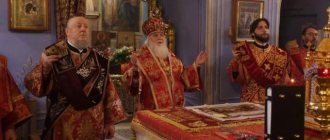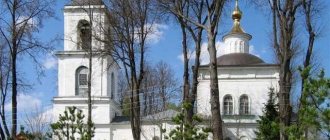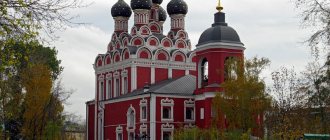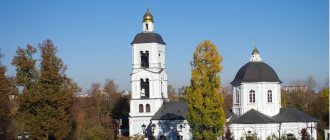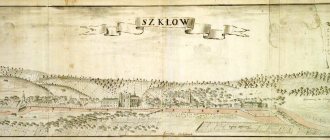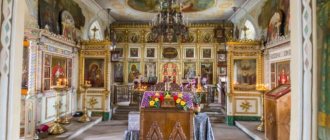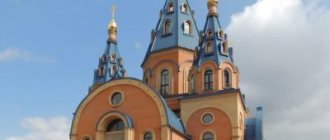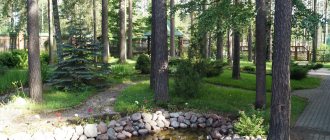In Russia, Orthodox churches have long served as the spiritual symbol of a village or city. Usually they were built in a prominent place or at a crossroads. Often the temple during hard times served as a refuge for believers and laity.
In Odintsovo, Moscow region, the Grebnevskaya Church is recognized as such a symbol. Townspeople consider it an unofficial symbol of the city, and pilgrims consider it a spiritual center.
Grebnevskaya Church in Odintsovo. The temple is the spiritual center not only of the village, but of the entire Moscow region
The first church in Odintsovo was founded by boyar Artemon Matveev
The temple in honor of the Grebnevskaya Icon of the Mother of God or the Grebnevskaya Church in Odintsovo, Moscow region is one of the oldest historical buildings in the city.
In ancient times it was of strategic importance, as it was located on the old Smolensk Highway. The road led from the western Russian borders to Moscow. It was considered one of the most important transport arteries, first of the Moscow and then of the Russian state.
1673 — 1679
at this time the first wooden church was built in Odintsovo
At first, a small village appeared on the road, from which the city grew. It was here that the first wooden church was erected in 1673 - 1679. As historical documents say, it was built “in the name of the holy martyr Artemon.”
The funds for construction were allocated by the boyar Artemon Sergeevich Matveev. At that time he owned the village of Odintsovo and was considered one of the richest people of his time.
Portrait of Matveev. I. Folveix, late 17th century. The first church in Odintsovo was built by the boyar Artemon Sergeevich Matveev in 1673-1679
Almost no information about the wooden church has survived. It is only known that the boyar spared no expense in decorating it. In addition, he acquired rich church utensils for the temple. Part of it survived until the construction of the new church. This suggests that he spared no expense in furnishing the temple.
Grebnevskaya Church was built instead of the old wooden church in the 1790s
The wooden church in Odintsovo fell into disrepair over time.
There was no point in repairing it.
1970-1980
at this time the old temple was demolished and a stone church was built in its place
That is why in the second half of the 1790s the old temple was demolished, and in its place a stone church was built in the name of the Grebnevskaya Icon of the Mother of God.
The construction was paid for by the new owner of the village, Countess Elizaveta Vasilievna Zubova.
Countess Elizaveta Vasilievna Zubova. 1742 - 1813. From a miniature belonging to M. E. Leontyeva, in Moscow
Construction of the Grebnevskaya Church was completed in the fall of 1801. They built a new church next to the old one in the name of the holy martyr Artemon. The Countess submitted a petition to the Most Reverend Seraphim, Bishop of Dmitrov, Vicar of Moscow.
The petition stated:
“... in my patrimony... the village of Odintsovo, instead of the dilapidated wooden Artemonovskaya church, a stone one was built from me in the name of the Grebnevsky Mother of God,
which is sufficiently decorated both externally and internally, equipped with a sacristy and other utensils and ready for consecration.”
Elizaveta Zubova
countess
The bishop gave a positive answer to the request and on November 22, 1801, the new church was consecrated by Archimandrite Theophan of the Mozhaisk Luzhetsky Monastery.
Temple in honor of the Grebnevskaya Icon of the Mother of God in the city of Odintsovo, view from the southern part. The church was built in classicism style
After the service began in the church, all the utensils from the old church were transferred to the new one, with the exception of some icons. The architectural style of the new church is classicism. This is the fashion of that time.
The serf peasants of Countess Elizaveta Vasilievna Zubova became her parishioners. The priest Fyodor Andrianov, sexton Ivan Fedotov, and sexton Nikolai Artemonovsky served in the built Grebnevsky church.
History of construction
In 1673, on the road leading from the western borders of Russia to Moscow, construction began on a village and church in honor of the holy martyr Artemon, belonging to the richest man of that time, boyar Artemon Sergeevich Matveev.
The boyar spared no expense in building a temple in honor of his guardian angel. The rich church furniture of the first wooden church was transferred to the new Christian monastery in 1790, after the old dilapidated church was dismantled.
Church of the Grebnevskaya Icon of the Mother of God in Odintsovo
In 1790, on the site of the old temple, the stone Grebnevskaya shrine of the Mother of God was erected, funds for the construction of which were allocated by the new owner of the village, Countess Elizaveta Vasilievna Zubova.
After 10 years, the construction was completed, the countess was proud of the splendor of the temple decoration, the architecture in the fashionable style of classicism, and submitted a petition for the consecration of the church in 1801.
On November 22, 1801, the consecration was performed by the archimandrite of the Mozhaisk Luzhetsk monastery Feofan, the first clergyman of the new church of the Grebnevskaya Icon of the Mother of God was Fedor Andrianov, and the main parishioners were the serfs of Countess Zubova.
In 1812, the Grebnevskaya shrine was desecrated by the French, who were retreating along the Smolensk road in accordance with the Russian military plan. Odintsovo passed from the Russians to the French and vice versa several times.
On September 1, 1812, prayers were held in the church for the granting of victory to the Russian troops stationed in Odintsovo, and on September 2, the cavalry troops of the French Marshal Murat were already in command here, robbed and desecrated the shrine.
Important! Until 1816, the Church of the Grebnevskaya Mother of God in Odintsovo was without a priest, although it was reconsecrated in 1813 after the victory over the French.
In 1870, the construction of the railway and the transformation of the village into a settlement became the impetus for the development of that area. New dachas appeared, and summer residents became parishioners of the Grebnevskaya Church, their number grew rapidly due to the proximity to Moscow and the rich picturesque nature, so a decision was made to expand the temple.
In the summer of 1898, a new refectory attached to the church was illuminated, a chapel of St. Nicholas of Myra appeared on the right, and a chapel in honor of St. Sergius of Radonezh and Savva of Storozhevsky appeared on the left. Also at that time, a three-tier bell tower was erected.
Time of revolution and destruction
Post-revolutionary persecutions did not immediately affect the Odintsovo shrine; services continued there, despite the lack of any support from the authorities. The maintenance of the temple and repairs fell on the shoulders of the priests, the church community melted away before our eyes, and the temple utensils were confiscated in 1920.
Photo of the Church of the Grebnevskaya Icon of the Mother of God from the 1920s
A terrible time came in 1938. The last rector of the temple, Archpriest Voronchev, witnessed the time when the Church of the Grebnevsky Icon of the Mother of God was finally plundered and closed, sending the priests into exile.
Father Alexander Voronchev was arrested in the church on November 3, 1938, during the service of the all-night vigil before the image of the Virgin Mary of Kazan, sent to a camp in Karelia, where he and other clergy suffered martyrdom, they were drowned in the hold of the boat.
From the memoirs of the daughter of the last deacon Vladimir, Nina Zapolskaya, it became known that her father was forced to slander priests, renounce his faith and rank, and as a result was exiled to the Northern camps, where he died in the city of Kirzhach.
The distraught Bolsheviks dug up the church cemetery in the hope of finding valuables and mocked the remains of the dead and crosses. Until 1960, the temple premises, damaged as a result of shelling during the Second World War, were used for economic needs, the iconostases were destroyed, the wall paintings were destroyed, and the bells were removed.
In 1960, the state took the dilapidated shrine under its guardianship, placing a dormitory and a bathhouse for soldiers, various institutions within the holy walls, and in 1989 it was decided to build a concert hall here, fortunately the acoustics allowed, but parishioners who began collecting signatures for the restoration of the temple prevented .
Rebirth time
March 1991 was the time of the return of the Odintsovo shrine to the Orthodox Church, priest Igor Borisov became its rector.
Divine services began in the early summer of the same year, and it didn’t matter that they were held in a small chapel, the priesthood and parishioners led a full church life from the first day, in parallel with the restoration of the Grebnevsky Church, a Sunday school for adults and children was opened.
Grebnevskaya Icon of the Mother of God
The following shrines were returned from the monastery of the Intercession of the Virgin Mary in the village of Akulovo:
- the holy image of the Mother of God “Grebnevskaya”;
- crucifixion
Unfortunately, these are so far the only ancient shrines returned after the closure of the temple. On July 2, 1995, His Eminence Gregory (Chirkov), Bishop of Mozhaisk, vicar of the Moscow diocese, consecrated the Church of the Grebnevskaya Icon of the Mother of God in Odintsovo.
During Napoleon's invasion, the Grebnevskaya Church was desecrated by the French.
The Grebnevskaya Church was desecrated and plundered by soldiers of Napoleon's troops. The fact is that Odintsovo is located on the old Smolensk road.
One of the goals of the Russian army in the War of 1812 was to force Napoleonic troops to retreat along it. That is why both Russian and French troops were actively moving around the village. The village moved from one side to the other several times.
Dmitry Kardovsky. Moscow in September 1812 (departure of the French from Moscow). 1908 - 1913. Edition by Joseph Knebel. During the occupation of Odintsovo in 1812, the French desecrated and plundered the Grebnevskaya Church
On the night of August 31 to September 1, after the end of the Battle of Borodino, the troops of the 1st and 2nd Western Russian armies settled down in Odintsovo. The priests of the Grebnevsky Church constantly served prayers for victory over the enemy.
In addition, Russian soldiers supported their spirit by seeing the shrines stored in it. On September 2, Odintsovo was already occupied by Murat’s cavalry, which became known from an intercepted letter from Napoleon.
1813 — 1816
during this period there was no priest at the temple
The French treated the church barbarously. They desecrated and plundered it.
From 1813 to 1816 there was no priest at the temple. Clergy records say that it was re-consecrated in 1813.
In the 1920-30s, the Grebnevskaya Church was closed, and the clergy were repressed
During the persecution of the Orthodox Church in the USSR, the Grebnevskaya Church did not close immediately. After the Revolution of 1917, services were held there for a long time. At the same time, the Soviet authorities did not provide any assistance to the parish.
The parish itself had to maintain and repair the temple. Naturally, the church community could not do this on its own. As for the church utensils, according to the decree of the All-Russian Central Executive Committee of February 23, 1922, they were removed from the church at the beginning of 1920.
Removal of the precious frame from the icon during the confiscation of church valuables. 1921 The parish of the Grebnevskaya Church was liquidated in 1938 - 1939. At the same time, church utensils were confiscated, and the church itself was closed and looted
The parish of the Grebnevskaya Church was liquidated in 1938-1939. The church itself was closed and looted. The building began to be used for economic purposes. The priests were persecuted and repressed.
In this, the priesthood of the temple shared the fate of all the priests of the Orthodox Church who lived in Russia at that time.
The last rector of the Grebnevskaya Church before its closure was Archpriest Alexander Voronchev.
It is known that the last rector of the church was the mitered archpriest Alexander Voronchev. On November 3, 1938, Father Alexander served an all-night vigil in honor of the Icon of the Kazan Mother of God. The priest was arrested right in the church.
He was sent for several years to the Karelian camps on Bear Mountain. The story is told about the martyrdom of the archpriest. He and other prisoners were drowned in the lake in the hold of a boat.
Church of the Grebnevskaya Icon of the Mother of God in Odintsovo. 1900s. The last deacon of the Grebnevsky Church, Vladimir, was exiled to camps in the North after he refused to renounce the priesthood and God
The daughter of the last deacon of the Grebnevsky Church, Nina Vladimirovna Zapolskaya, has survived to this day. She talked about how the authorities forced her father to renounce God and his rank. After refusing, he was arrested and exiled to camps in the North.
Deacon Vladimir died while settling in the city of Kirzhach. She said that in a frenzy, people desecrated the cemetery at the church: they tore up graves and dragged the remains of the dead around the cemetery in the hope of finding jewelry and crosses.
Grebnevsky Temple
HISTORICAL REFERENCE
Temple in honor of the Grebnevskaya Icon of the Mother of God
Odintsovo, Moscow region
The old Smolensk Highway led from the WESTERN BORDERS of Russia to Moscow. On the Mozhaisk section of this road is the city of Odintsovo, which was previously a small village. In 1673-1679. here the first wooden church was built “in the name of the holy martyr Artemon.” It was built at the expense of the owner of the village of Odintsovo, boyar Artemon Sergeevich Matveev, one of the wealthiest people of his time. This suggests that the church was richly decorated and decorated.
In the second half of the 1790s, the village passed into the hands of Countess Elizaveta Vasilyevna Zubova, who, instead of the dilapidated old wooden church, decided to build a stone church in the name of the Grebnevskaya Icon of the Mother of God.
In the autumn of 1801, the construction of the Grebnevskaya church was completed and Countess Elizaveta Vasilievna, in a petition submitted to the Bishop Seraphim of Dmitrovsky, vicar of Moscow, wrote: “... in my patrimony ... the village of Odintsovo, instead of the wooden dilapidated Artemonovskaya church, a stone one was built from me again in the name of the Grebnevsky Mother of God, which as splendor on the outside, and the inside is sufficiently decorated, equipped with a sacristy and other utensils and ready for consecration.” And on November 22, 1801, the church was consecrated by Archimandrite Feofan of the Mozhaisk Luzhetsky Monastery.
With the beginning of the service in the Grebnevsky Church, the dilapidated church of the holy martyr Artemon was dismantled, and all its utensils “except for a certain number of images, were converted into the new” church. At that time, priest Fyodor Andrianov, sexton Ivan Fedotov, and sexton Nikolai Artemonovsky served in the Grebnevsky Church. The parishioners of the church were the serf peasants of Countess Zubova.
In 1812, on the night of August 31 to September 1, after the Battle of Borodino, the troops of the 1st and 2nd Western Russian armies settled down for the night in Mamonov in Odintsovo. Prayers for victory over the enemy were served in the Grebnevskaya Church, and its shrines supported the spirit of Russian soldiers. Napoleonic troops, heading towards Moscow, changed their disposition in almost the same villages. On September 2, as Napoleon reported in his letter, Murat’s cavalry was in Odintsovo.
The Grebnevsky Church was subjected to desecration and destruction by the French, since from 1813 to 1816. there was no priest at the temple. According to the clergy registers of 1813, the church was preparing for a new consecration.
In the early 1870s, with the commissioning of the new Moscow-Smolensk-Brest railway, the station village of Odintsovo appeared, around which dachas grew. Already in 1890 there were 125 of them.
By the summer of 1898, at the request of parishioners, a refectory with two borders was added to the temple: on the right side in the name of St. Nicholas the Wonderworker and on the left in the name of St. Sergius of Radonezh and Savva of Storozhevsky. A new bell tower of three tiers was also built.
AFTER THE REVOLUTION of 1917, divine services continued in the Grebnevskaya Church. The maintenance and repair of the church was entrusted exclusively to the church community. No archival documents have been found about any repairs to the Odintsovo Church during Soviet times. All his precious utensils were apparently confiscated at the beginning of 1920 in accordance with the resolution of the All-Russian Central Executive Committee of February 23, 1922.
In 1938-1939 the parish of the Grebnevskaya Church ceased to exist. The church was closed and looted. And then it began to be used for economic purposes in the village. The fate of the temple priesthood is a reflection of the fate of the entire clergy of the country. The last rector in our church before its closure was Mitred Archpriest Alexander Voronchev. On November 3, after the all-night vigil on the holiday in honor of the Kazan Mother of God, he was arrested. Father Alexander spent several years in camps in Karelia on Medvezhya Mountain and, together with the prisoners of this camp, suffered a martyr’s death: the camp prisoners were herded onto a large boat and launched into a lake, where the boat was destroyed by bombs from airplanes. The brethren of the Grebnevsky Church established a day of remembrance for Archpriest Alexander - November 3 (since the exact date of death is not known). The daughter of the last deacon of the Grebnevskaya Church, Nina Vladimirovna Zapolskaya, has survived to this day. She told us about her father's Stations of the Cross. After Deacon Vladimir did not want to officially renounce God and the priesthood, he was arrested and exiled to the northern camps. Deacon Vladimir died in the city of Kirzhach during a settlement. According to Nina Vladimirovna Zapolskaya, after the closure of the temple, the cemetery at the church was desecrated. Brutalized people dug up graves, dragged skulls by their long hair, trying to find jewelry and crosses.
At the beginning of the Great Patriotic War, the church building was shelled. After the war, the western entrance to the bell tower was blocked, new window and door openings were made, the iconostasis, most of the wall paintings, old floors, the temple fence and bells disappeared. And as if in mockery, on August 30, 1960, Resolution No. 1327 of the Council of Ministers of the RSFSR was issued on “taking the former Grebnevskaya Church under state protection.”
VARIOUS ORGANIZATIONS “PROTECTED” THE CHURCH BUILDING. At various times, there were utility warehouses, a soldier's bathhouse, a dormitory, and various offices here. 29 years later, in 1989, it was announced that the building “should serve the cultural and spiritual education of the townspeople.” It was decided to rebuild the church into a concert hall. Orthodox residents of the city of Odintsovo began collecting signatures for the transfer of the building of the Grebnevskaya Church to the Orthodox community. In March 1991, the Grebnevsky Church was transferred to the community of believers of the Russian Orthodox Church, and priest Igor Borisov was appointed rector.
The first services were held in a small chapel. But already in June 1991, parishioners prayed at the first Liturgy on the Feast of the Most Holy Trinity.
The temple was also being built inside. The wall paintings in the rotunda were restored. Residents brought ancient icons and books as gifts to the temple. From the previous decoration of the temple, only two shrines have survived to this day: the temple icon of the Grebnevskaya Mother of God and the Crucifixion. They were in the Church of the Intercession in the village. Akulovo and after the opening of the Grebnevsky temple were transferred here.
On July 2, 1995, during the Sunday Liturgy, the complete consecration of the church in the name of the Grebnevskaya Icon of the Mother of God took place, which was performed by His Grace Gregory, Bishop of Mozhaisk, vicar of the Moscow diocese.
Currently, restoration work is underway in the temple. In 2002, with donations from parishioners, Palekh craftsmen made and installed new carved iconostases made of mahogany and icon cases for especially revered icons: the Grebnevskaya Icon of the Mother of God, the Hieromartyr Haralampius, the Prophet Elijah, the “Quench My Sorrows” icon, “The Inexhaustible Chalice”, etc. .
There is a Sunday school at the temple. There are 6 groups working at the school. Classes in younger groups (from 3 to 7 years old) are held together with parents, the Orthodox tradition, the church calendar and the lives of saints are studied. In the middle groups, the Law of God is taught. Older children study the basics of morality, liturgy and history. Gospel conversations are held for parishioners once a week. Activities are organized for children and adults: wood carving, embroidery with beading, wood painting. Educational meetings are held at Sunday School for parents and teachers once or twice a month. For the holidays, Sunday School students prepare concerts, stage exciting performances, and congratulate the children of the school for the disabled and the orphanage.
In March 2000, an Orthodox Youth Center was organized at the Grebnevsky Church. The main direction of the Center’s work is participation in Divine services, altar and choir obedience. Another form of work of the Center is charitable activities. Young people from the Center are frequent guests at the Odintsovo orphanage, the Nadezhda school, a military unit, and a military hospital. In the city hospital, the guys take care of the sick and carry out various tasks. Young people often go on pilgrimage trips to the saints of Russia and the Moscow region. The Center organizes sports sections, clubs, solfeggio and vocal classes, and a guitar club.
In the summer, the youth of the deanery work and relax in a summer youth camp located in the picturesque surroundings of Zvenigorod in the village of Lutsino. The Divine Liturgy is celebrated daily in the camp. The life of the camp is led by the priests of the Deanery.
Divine services in the Grebnevsky Church are held daily.
During Soviet times, the church building was used for economic purposes
During the Great Patriotic War, the temple buildings were heavily damaged by artillery shelling.
After its completion, the building was finally transferred to the category of outbuildings.
August 30, 1960
the temple was taken under state protection
To do this, they blocked the western entrance to the bell tower, made new door and window openings in the walls, removed the iconostases, as well as most of the wall paintings, the temple fence, bells, and old floors.
Moreover, on August 30, 1960, the state took the temple under state protection.
Grebnevskaya Church. Odintsovo. Nowadays. In 1991, the building of the Grebnevsky Church was transferred to the Russian Orthodox Church
Later, various organizations were housed in the temple building. There were utility warehouses, a soldiers' bathhouse, a hostel, and Soviet organizations here. In 1989, the city authorities of Odintsovo decided to rebuild the church building into a concert hall.
Orthodox residents of the city did not agree with this decision and began collecting signatures for the transfer of the building to the Russian Orthodox Church. In March 1991, their request was granted, and priest Igor Borisov was appointed rector of the Grebnevsky Church transferred to the Church.
In the 1990s, the revival of the Grebnevsky Church began
While the building of the temple returned to the Church was being put in order, services were held in a small chapel.
In June 1991, on Trinity Sunday, prayer was already happening at the first Liturgy there.
1991
in June of this year the first liturgy was held in the church
In the same year, a Sunday school was opened at the church for adults, and later for children.
From this moment on, it is believed that the parish of the church returned to church life in full.
Icon of the Mother of God of Grebenskaya. Book engraving of the 19th century. After the transfer of the Grebenskaya Church in Odintsovo to the Russian Orthodox Church, it turned out that from the previous decoration only the icon of the Grebenskaya Mother of God and the Crucifixion were preserved
Work was also carried out to improve the interior of the temple. For this purpose, the paintings in the rotunda were restored. Residents of the city themselves brought icons and books as gifts to the church.
Unfortunately, from the previous decoration of the Grebenskaya Church, only two have survived: the icon of the Grebenskaya Mother of God and the Crucifixion. Before returning to the temple, they were kept in the Church of the Intercession in the village. Akulovo.
From the previous decoration of the Grebenskaya Church, only two shrines have survived.
The complete consecration of the temple in the name of the Grebenskaya Icon of the Mother of God took place on July 2, 1995. It was performed by His Grace Gregory (Chirkov), Bishop of Mozhaisk, vicar of the Moscow diocese.
From 1990 to 2000, large-scale restoration work was carried out in the temple. They were financed by donations from parishioners.
As a result, Palekh craftsmen made and installed carved iconostasis of their mahogany for such especially revered icons as: the Grebenskaya Icon of the Mother of God, the Hieromartyr Haralampius, the Prophet Elijah, the icon of the Mother of God “Quench My Sorrows”, “The Inexhaustible Chalice” and others.
Architecture
The priesthood began to conduct active social work among the population from the first days after the opening of the church, with the parallel restoration of paintings, iconostasis, and bell tower. A massive dome covers a low two-color rotunda, which does not catch the eye with its splendor, but attracts the eye with the uniqueness of its architecture, moving from classicism to empire style.
The external simplicity is diluted by panels, medallions and order motifs of the window openings; in the north-east of the temple there is an ancient chapel, covered by a rafter tent.
Nowadays, there is an active spiritual life in the Grebensky Church
The church in honor of the Grebenskaya Icon of the Mother of God is the main one for a number of other churches. This is how they are assigned to him:
- martyr's chapel John the Warrior;
- house church of the prmts. led book Elizabeth;
- mcc temple Faith, Hope, Love and their mother Sophia;
- Church of the Icon of the Mother of God “Healer”;
- Hospital Church of St. Luke of Simferopol;
- Chapel of the Icon of the Mother of God “Life-Giving Source”;
- Church of the Icon of the Mother of God of Vladimir.
Odintsovo Orthodox Cultural Center.
The Grebensky Church in Odintsovo is the center of the spiritual life of the region. It operates an Orthodox cultural center for adults and children. The temple is one of the centers of spiritual life in the Moscow region. It runs a Sunday school. 6 groups have been created. Here the Orthodox tradition, the lives of saints, the Law of God, and history are studied.
In addition, the school runs hobby groups for children and adults. School students prepare concerts and stage plays for the disabled and an orphanage.
An Orthodox Youth Center was opened at the Grebenskaya Church in 2000.
In 2000, an Orthodox Youth Center was opened at the church. His main area of work is participation in Divine services, altar and choir obedience.
The center is also involved in charity work. There are clubs at the Center.
His students go on pilgrimages and help care for the sick in the city hospital.
Odintsovo district. Orthodox youth camp. The priests of the Grebenskaya Church organize and lead an Orthodox youth camp every year
A youth camp is organized at the temple in the summer. It is opened in the vicinity of Zvenigorod in the village of Lutsino. This is a picturesque area. The camp is run by temple priests. Liturgy is celebrated there daily.
Adults at the church can gain additional knowledge at Missionary and Theological diocesan courses.
Modern life
Rector Grigory Fedotov supervises the learning process in Sunday school, where, depending on age, the Biblical history of the Old and New Testaments, the basics of Liturgics, Catechism, Orthodox worship and altar obedience are studied.
Classes for children aged 4 years and older are conducted in a playful way, with films and slides shown, children learn songs and do handicrafts, each lesson ends with a joint tea party. Older children and youth take an active part in preparing for concerts, which are held in hospitals, hospitals, nursing homes and orphanages during religious holidays.
Children's ministry at Grebnevsky Church
All services are accompanied by choir singing; there are six groups of different ages in the parish. They don’t forget about sports here, where in addition to football, table tennis and gymnastics for children, there is a rehabilitation group for adults and training schoolchildren in hand-to-hand combat and the basics of Greco-Roman wrestling.
To attract young people to Orthodox life, a Youth Club has been opened, and there are clubs for making ceramics, creating masterpieces using isothreads, and studying the basics of icon painting. Joint pilgrimage trips to holy places are regularly made. In the summer, children's camps are organized by church-going parishioners and priests.
Divine services are held daily in the Grebensky Church
The rector of the Grebensky Church is priest Grigory Fedotov. Clergy:
- priest Vadim Aleksandrovich Shinkevich;
- priest Konstantin Aleksandrovich Ilyin;
- priest Nikolai Dmitrievich Kolesnik;
- priest Gleb Vladimirovich Fedotov;
- priest John Anatolyevich Vilipas;
Official website of the Grebensky Temple
In the Grebensky Odintsov Church, services are held daily. You can check the schedule of services on the official website of the temple.
Patronal feast day of the Grebenskaya Icon of the Mother of God (August 10). Divine services in the Grebensky Church are held daily.
You can check the schedule on the official website of the parish.
Parish telephone (fax), (498) 595-17-35
The Grebenskaya Church in Odintsovo should not be confused with the same one in Fryazino.
It should be noted that nearby, in the Fryazino area, there is another Grebenskaya Church. It should not be confused with the Odintsovo temple.
Address of the first: Moscow region, Fryazino, village. Grebnevo, 30. Second address: Moscow region, Odintsovo, Odintsovo district, Mozhaiskoe highway, 72.
Directions to the church in the name of the Grebenskaya Mother of God in Odintsovo.
Since the temple is located next to the Mozhaisk highway, it is easy to reach. In the same case, if you want to organize a pilgrimage, you must contact the rector of the temple in advance. He will tell you on what day you can visit the church to venerate its shrines.
By leaving a comment, you accept the user agreement
